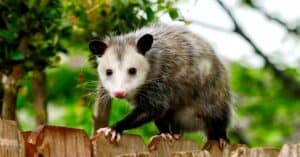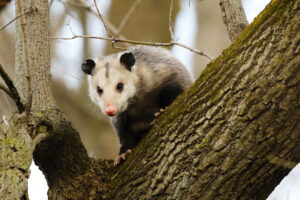Forget what you think you know about opossums. These aren’t the garbage-eaters you’ve been told about. Virginia opossums (Didelphis virginiana) are resilient, adaptive marsupials that play an important role in the environment. Not to be confused with the possums of Australia, the Virginia opossum is native to North America and has many unique traits that make it unlike any other animal. Here are nine things you didn’t know about Virginia opossums.
1. They’ve Been Around Since the Age of Dinosaurs
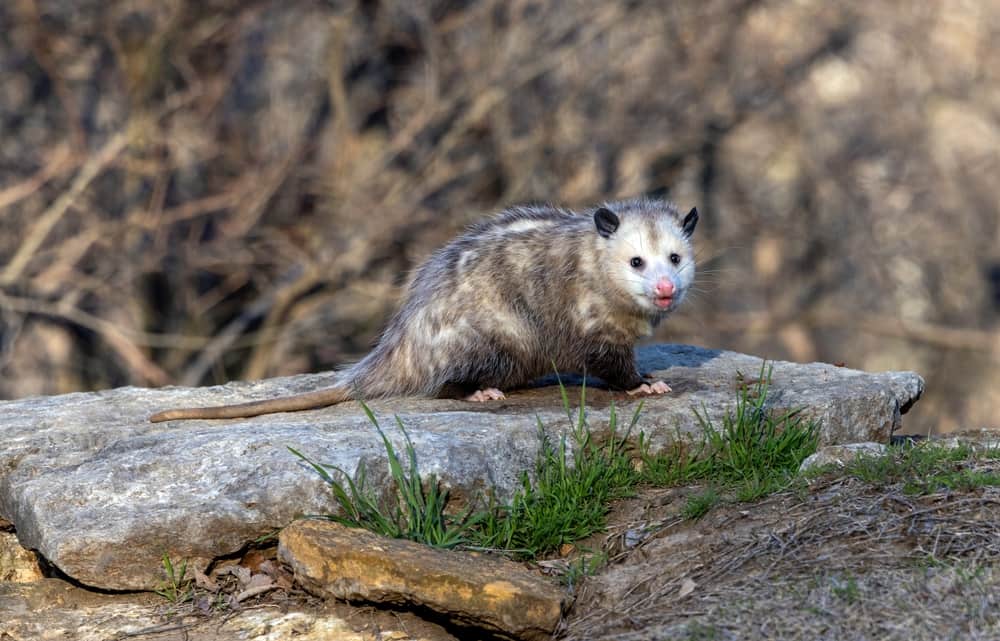
Opossums walked the earth at the same time as the Tyrannosaurus.
©Bert B/Shutterstock.com
While the opossums in your neighborhood are probably new neighbors, opossums as a species have been around since dinosaurs roamed the earth. Scientists have found opossum fossils dating to the Cretaceous-Paleogene period around 65 million years ago — right around the same time as the extinction event that killed the dinosaurs.
Today, marsupials only live in the Americas and Australasia, but fossils of these animals have been found on all seven continents. Remarkably, the opossum has remained practically unchanged in all that time. The Virginia opossum as we know it today first evolved during the Miocene period, approximately 23 million years ago. Due to this longevity, scientists often refer to opossums as living fossils. The species has lasted for this long due to the opossum’s adaptability, which has allowed it to adapt well to varied environments, including urban settings.
2. They Are North America’s Only Marsupial
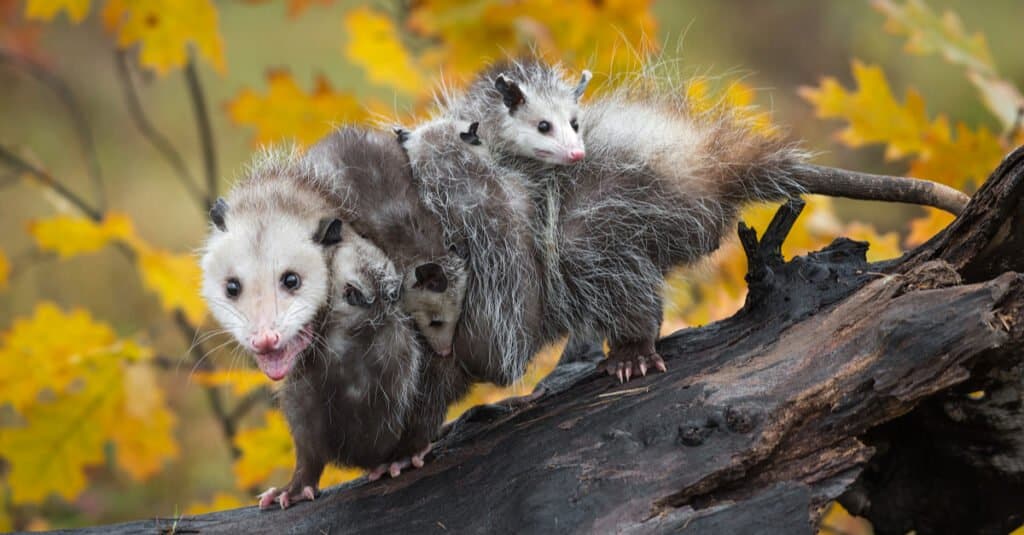
Virginia opossums live as far south as Costa Rica and range north all the way to Ontario, Canada.
©Holly Kuchera/Shutterstock.com
While there are over 330 species of marsupials in the world (and over 100 species of opossum), the Virginia opossum is the only one in North America. Around two-thirds of marsupials (including kangaroos, wombats, pygmy possums, and Tasmanian devils) live in Australia, while the remaining third is primarily located in South America.
The Virginia opossum is the only marsupial that has ventured north of Mexico in the Americas. While marsupials were prevalent in North America during the Eocene period, they disappeared from the continent around 25 million years ago during the Oligocene age. However, opossums returned to what is now the United States when the Panamanian land bridge was formed between North and South America around 3 million years ago — and they’ve been here ever since.
3. Their Gestation Period Is Remarkably Short
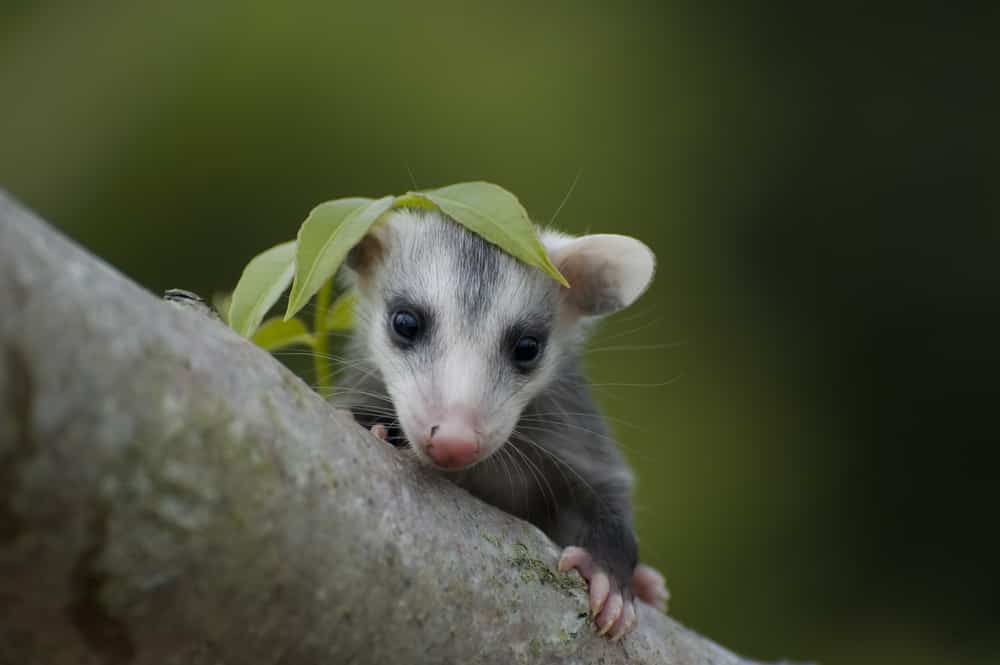
Opossums have the shortest gestation period of any mammal.
©Heiko Kiera/Shutterstock.com
While opossums have lasted a long time, their pregnancies do not! Opossums have an amazingly short 10–12 day gestation period, the shortest of any mammal. This is possible because most of a baby opossum’s development takes place in the marsupial’s trademark pouch. They are so undeveloped that an opossum’s brain is only 9% developed when they are born! They are the size of a jellybean at birth and weigh a mere 3-5 grams. Born hairless and with their eyes sealed shut, they have to immediately make their way to their mother’s pouch where they will continue to develop for the following two months.
4. Opossum Babies Have a Big Journey
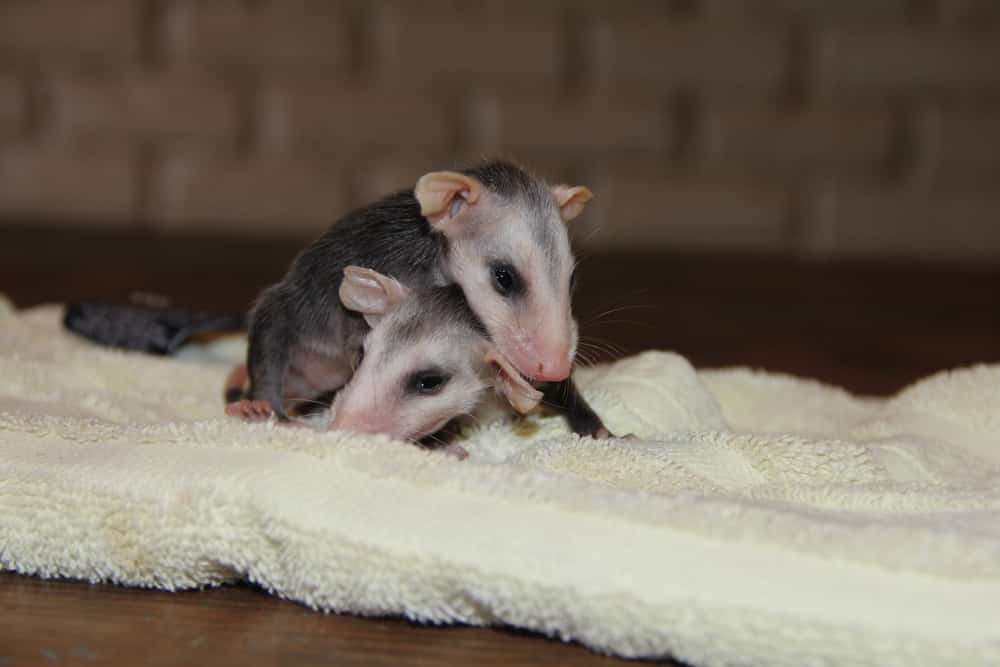
A baby opossum’s eyes are sealed shut at birth and don’t open until they are 50-70 days old.
©5Foote/Shutterstock.com
Virginia opossums have a big task ahead of them directly after birth: making their way to their mother’s pouch. Babies use their fingers and nails to pull themselves several inches from the birth canal to the pouch on the mother’s belly. To help the babies find their way, the mother will part her fur in the area by licking a path to her pouch. Any babies that don’t find their way to the pouch will die within a few minutes.
To combat the casualties of this journey, opossums will have one to three litters per year, with an average of 9-13 babies. Babies leave the pouch when they are around 2.5 months old and ride around on their mother’s back until 4 months of age. After this, the juveniles will strike out on their own and remain solitary until it comes time to breed (which is often!). In the Midwest, the first litters of the year are usually born in March, with litters born as late as October.
| Opossum Life Milestones | Timeline |
|---|---|
| Gestation | 10-12 days |
| Eyes open | 50-70 days |
| Leave pouch | 2-2.5 months |
| Weaned | 3 months |
| Independent | 4-4.5 months |
5. Opossums Have 13 Teats
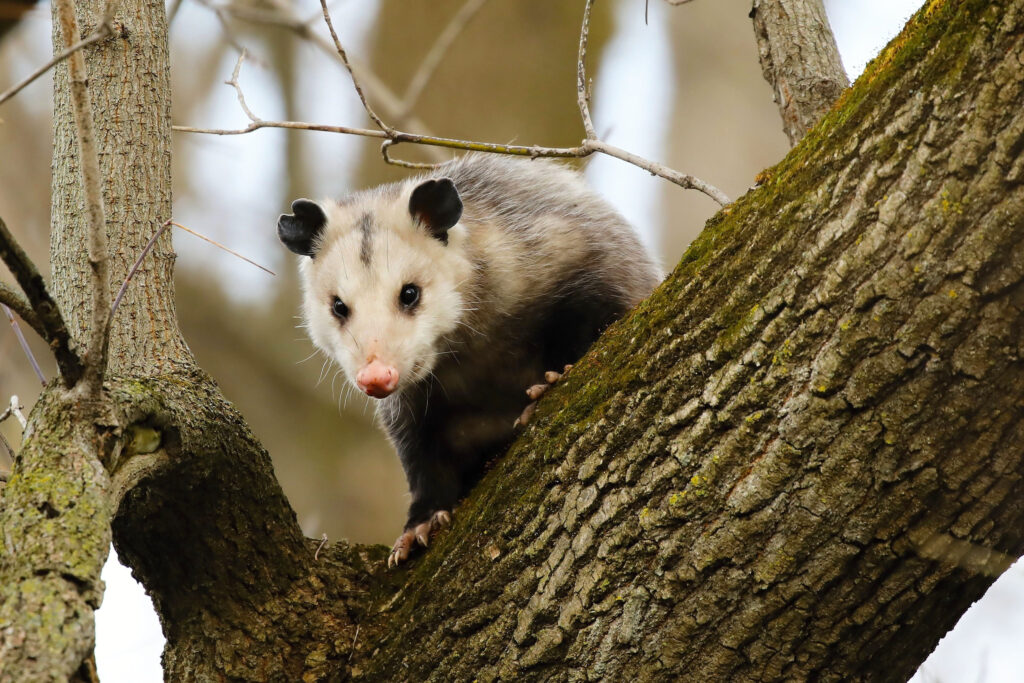
Virginia opossums are great climbers, and can even scale smooth surfaces.
©Karel Bock/Shutterstock.com
Once a baby opossum makes it to the pouch, they still have a big challenge. They have to find a teat! This isn’t always as easy as it sounds; while opossums can have up to 25 babies, they only have 13 teats. This means that any babies that are slow to the pouch may not get a teat.
Finding a teat is particularly critical because baby opossums permanently clamp to the mother’s teat for two months. Their mouths form a seal around it and don’t let go. Since they don’t surrender the teat like other mammals, there is no sharing among siblings, and any babies that don’t attach will die.
Having an odd number of teats is, well, odd! Opossums are the only mammals that don’t have an even number of teats. The teats are arranged in a “U” shape, with 12 around the outside and one placed in the middle. Over the 60 days that the babies are latched on to nurse, the opossum’s teat will stretch out to around 35 times its original length, allowing the babies to essentially swallow the teat. This functions as an umbilical cord-like tether between the baby and the mother. The tether is so strong that manually removing babies from the pouch is almost impossible without tearing the teat. Due to this, no one except a licensed wildlife rehabilitator should ever attempt to remove opossum babies from the pouch.
6. They Have More Teeth Than Any North American Mammal

Opossums use their 50 teeth to intimidate threats.
©iStock.com/rexlis
If you’ve ever seen an opossum bare its teeth, you know there are a lot of them! Opossums have 50 teeth, more than any North American mammal. In comparison, humans have 32 teeth, and bears have 42. Worldwide, the only mammals with more teeth than an opossum are bottlenose dolphins (72-104 teeth) and giant armadillos (80-100 teeth).
Opossums have heterodont teeth, which means that there are different tooth shapes in the tooth row, including incisors, canines, premolars, and molars. While humans have eight incisors, opossums have 18! The opossum’s varied teeth allow them to eat a variety of foods, including carrion, eggs, fruits, vegetables, and crustaceans.
Shy by nature, opossums rarely use their teeth to bite people or other animals. Instead of biting, their defense mechanism is to open their mouths wide and pull back their gums to try to intimidate predators with all of their pointy teeth. They will also often hiss and drool while doing this. Despite this nonviolent showmanship, opossums — like anything with a mouth — can bite if they feel threatened enough, so the only surefire way to avoid being bitten is to not attempt to handle, pick up, or hold wild opossums.
7. They Are Nomadic
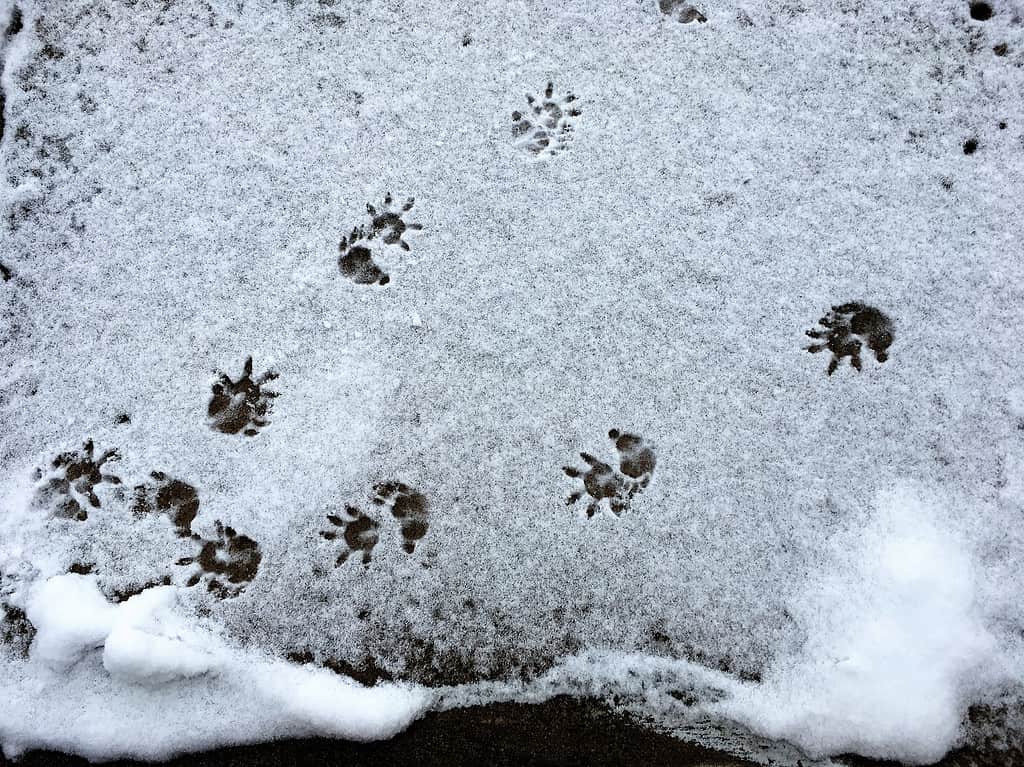
Opossums will travel up to 2 miles for food in a single night.
©jelloyd/Shutterstock.com
Many people have concerns about opossums living under their decks or in their sheds. However, it is rare for an opossum to set up a permanent home. Opossums are nomadic, and will only stay in one area as long as food and water are readily available. They rarely put in the effort to build their own dens, though they have been known to carry leaves in their prehensile tails to make a temporary home more comfortable.
Virginia opossum territories vary in size, ranging anywhere from 10-300 acres. Opossums are not protective of their territories, so individual territories often overlap. One square mile may support up to 20 opossums at the same time, provided there are adequate resources.
8. Opossums Have Short Lifespans

Opossums will often play dead to confuse and deter predators.
©iStock.com/ScrappinStacy
Although opossums as a species have been around for millennia, individual opossums don’t live for that long. On average, a Virginia opossum in the wild will only live for around two years. The oldest opossum collected in the wild was only 3 years old. This short lifespan is one reason they have so many babies, as the need to repopulate is high.
Opossums in captivity can live longer (3-4 years), due to the lack of predators and threats such as automobiles. The oldest Virginia opossum on record in captivity lived to be 6.6 years old.
9. Virginia Opossums Are Great for the Environment
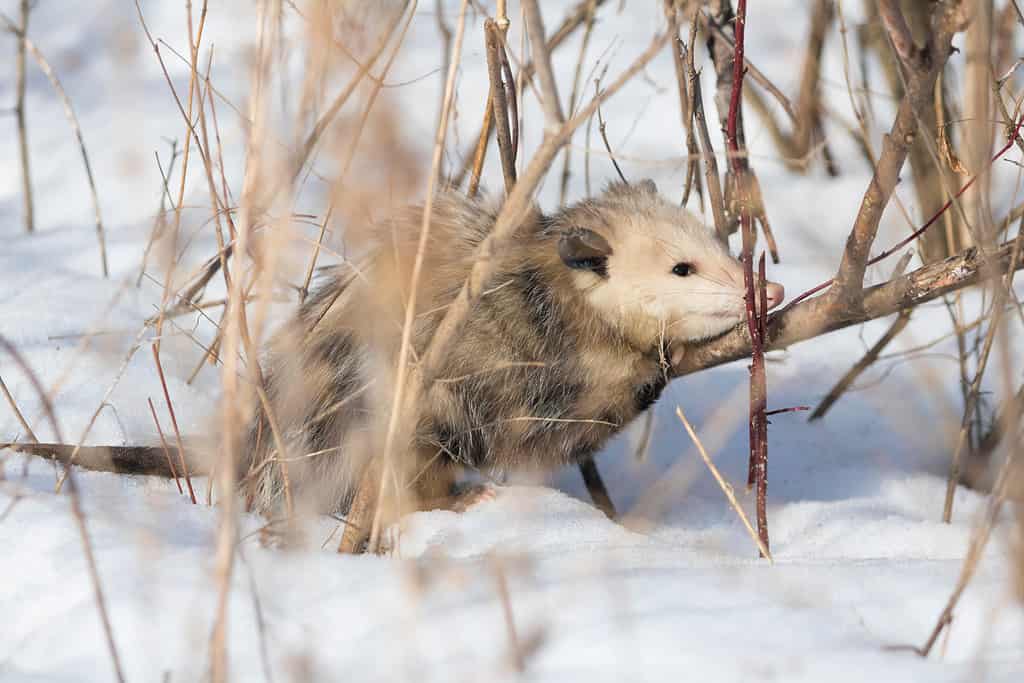
Virginia opossums are active year-round and often suffer frostbite on their ears, tails, and toes during winter months in cold climates.
©KB Digital/Shutterstock.com
Despite their reputation, opossums should not be seen as nuisance animals, as they are actually very beneficial to have around. Opossums eat slugs, insects, and rodents that can invade and damage gardens and yards. Their taste for these creatures, as well as snakes, cockroaches, and other small animals, helps prevent the overpopulation of these pests. They also eat mosquitos and ticks, which can help prevent the spread of Lyme disease and other diseases.
Opossums are also nature’s best garbagemen! As omnivorous scavengers, they eat carrion, rotten fruit, compost, and loose garbage, keeping our neighborhoods cleaner. Opossums actually prefer rotten foods to fresh ones, so they enjoy cleaning up around fruit trees and trash cans. These marsupials also have a natural resistance to both botulism and rabies, so the likelihood of them spreading disease to people or other animals is low.
Summary of Opossum Facts
| Number | Fact |
|---|---|
| Fact #1 | Opossum fossils date back 65 million years, to the time of dinosaurs. |
| Fact #2 | There are over 100 species of opossum in the world, but the Virginia opossum is the only one in North America. |
| Fact #3 | The Virginia opossum’s gestation period is only 10-12 days, the shortest of any mammal. |
| Fact #4 | After birth, baby opossums must crawl across their mother’s stomach to reach the pouch. |
| Fact #5 | Female opossums have 13 teats inside their pouches. |
| Fact #6 | Opossums have 50 teeth, more than any other North American mammal. |
| Fact #7 | Virginia opossums are nomadic and don’t make permanent dens. |
| Fact #8 | The lifespan of a wild opossum is only 2 years. |
| Fact #9 | Opossums eat pests and carrion and are great for the environment. |
The photo featured at the top of this post is © iStock.com/galinast
Thank you for reading! Have some feedback for us? Contact the AZ Animals editorial team.




